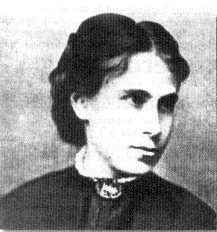Tina Blau
Tina Blau, later Tina Blau-Lang (15 November 1845, Vienna - 31 October 1916, Vienna)[1] was an Austrian landscape painter.
Tina Blau-Lang | |
|---|---|
 Tina Blau (1870s) | |
| Born | Tina Blau November 15, 1845 Vienna, Austria |
| Died | October 30, 1916 (aged 70) Vienna, Austria |
| Nationality | Austrian |
| Known for | Painting |
| Spouse(s) | Heinrich Lang |

Life
Blau's father was a doctor in the Austro-Hungarian Medical Corps and was very supportive of her desire to become a painter.[1] She took lessons, successively, with August Schaeffer and Wilhelm Lindenschmit in Munich (1869–1873).[2] She also studied with Emil Jakob Schindler and they shared a studio from 1875 to 1876, but apparently broke off the arrangement after a quarrel. Later, at the art colony in Plankenberg Castle, near Neulengbach, she briefly became his student again.
In 1883, she converted from Judaism to the Evangelical Lutheran Church[3] and married Heinrich Lang, a painter who specialized in horses and battle scenes. They moved to Munich where, from 1889, she taught landscape and still life painting at the Women's Academy of the Münchner Künstlerinnenverein (Munich Women Artists' Association). In 1890, her first major exhibition was held there. Blau exhibited her work at the Palace of Fine Arts at the 1893 World's Columbian Exposition in Chicago, Illinois.[4]
After her husband's death, she spent ten years travelling in Holland and Italy.[2] After her return, she established a studio in the Rotunde.[5] In 1897, together with Olga Prager, Rosa Mayreder and Karl Federn, she helped found the "Wiener Frauenakademie", an art school for women, where she taught until 1915.
She spent her last summer working in Bad Gastein, then went to a sanatorium in Vienna for a medical examination. She died there of cardiac arrest.[5] She was given an "Ehrengrab" (Honor Grave) in the Zentralfriedhof.[6] The Vienna Künstlerhaus auctioned off her estate and held a major retrospective in 1917.[7]
References
- Ben-Eli, Birgit. "Tina Blau 1845 – 1916". Jewish Women's Archive. Retrieved 21 July 2017.
- A. F. S. (d. i. Adalbert Seligmann): † Tina Blau-Lang. In: Neue Freie Presse, 31 October 1916, p. 25 (Online at ANNO)
- Anna L. Staudacher: "… meldet den Austritt aus dem mosaischen Glauben". 18000 Austritte aus dem Judentum in Wien, 1868–1914: Namen – Quellen – Daten. Peter Lang, Frankfurt/M. u.a. 2009, ISBN 978-3-631-55832-4
- Nichols, K. L. "Women's Art at the World's Columbian Fair & Exposition, Chicago 1893". Retrieved 30 July 2018.
- A. F. S. (d. i. Adalbert Franz Seligmann): Ein letzter Besuch. In: Neue Freie Presse, 10 November 1916, p. 01 (Online at ANNO)
- Hedwig Abraham: Tor 4 – evangelische Ehrengräber. (…) Regina – „Tina“ Blau. In: viennatouristguide.at; retrieved, 26 February 2012.
- Tina Blau [Ill.]: Versteigerung des künstlerischen Nachlasses der Landschaftsmalerin Tina Blau. Mittwoch, den 28 März 1917. Öffentliche Ausstellung daselbst von Sonntag den 25. bis am Dienstag den 27. März 1917. Serie: C. J. Wawra, Wien: Kunstauktion von C. J. Wawra, ZDB-ID 1224898-8. Wawra, Wien 1917.
Further reading
- Tobias Natter, Claus Jesina: Tina Blau (1845–1916). Verlag Galerie Welz, Salzburg 1999, ISBN 3-85349-232-0.
- Monika Salzer, Peter Karner: Vom Christbaum zur Ringstraße. Evangelisches Wien. Picus, Vienna, 2008, ISBN 978-3-85452-636-0.
External links
| Wikimedia Commons has media related to Tina Blau. |
- Literature by and about Tina Blau in the German National Library catalogue
- "Frauen in Bewegung": multiple short biographies @ the Österreichische Nationalbibliothek